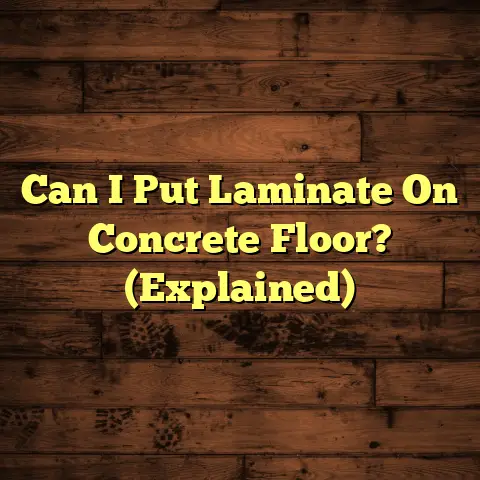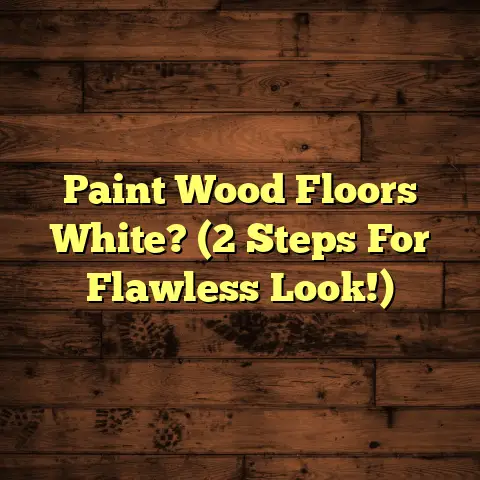Cement Floor Cost: Calculate Now! (4 Min Read)
Ever find yourself staring at a worn-out floor, dreaming of something durable, stylish, and budget-friendly?
I get it! I’ve been there countless times with clients.
Let me tell you about Sarah and Mark, a young couple who bought their first home. They were buzzing with excitement, but the old linoleum in the kitchen?
Not so much. They explored hardwood, tile, even laminate.
But everything seemed either too expensive or not quite right.
Then, they stumbled upon cement flooring.
They were initially hesitant. Cement? In a home? But the more they researched, the more they fell in love with its modern look and incredible durability.
Plus, the cost was a pleasant surprise!
Their story isn’t unique. Many homeowners and businesses are discovering the appeal of cement flooring.
But before you jump in, let’s break down the costs, so you can make an informed decision.
Section 1: Understanding Cement Flooring
Okay, so what exactly is cement flooring?
It’s not just gray, boring concrete anymore!
Think of it as a versatile canvas for your floors.
There are a few main types:
-
Polished Concrete: This is where existing concrete slabs are ground down and polished to a smooth, shiny finish. It’s super popular for its sleek, modern vibe.
-
Stamped Concrete: This involves pouring fresh concrete and then using stamps to create patterns and textures, mimicking tile, brick, or even wood.
-
Traditional Poured Cement Floors: This is your classic cement floor, often left with a more raw, industrial look.
What are the benefits?
Well, where do I even start?
-
Durability: Cement floors are tough! They can withstand heavy foot traffic, kids, pets – you name it.
-
Ease of Maintenance: Seriously, a quick sweep and mop are usually all you need.
-
Aesthetic Versatility: From modern and minimalist to rustic and industrial, cement floors can adapt to almost any style. You can stain them, dye them, polish them – the possibilities are endless!
Where can you use cement flooring?
Everywhere! I’ve seen it in:
-
Residential: Kitchens, living rooms, basements, bathrooms – basically any room in the house.
-
Commercial: Retail stores, restaurants, offices – its durability makes it perfect for high-traffic areas.
-
Industrial: Warehouses, factories, garages – where toughness is a must.
Section 2: Factors Influencing Cement Floor Costs
Alright, let’s get down to the nitty-gritty: the costs.
Several factors can impact the final price, so let’s break them down.
Material Costs
This is the foundation of your cement floor cost.
-
Cement: The type of cement mix you choose will affect the price. Some mixes are stronger, more durable, or have special additives.
-
Aggregates: These are the materials mixed with cement, like sand, gravel, or crushed stone. The type and quality of aggregates can influence the cost.
-
Additives: These are special ingredients added to the cement mix to enhance its properties, such as color, strength, or workability.
Average Prices (per square foot – these are estimates and can vary):
| Material | Average Price per Square Foot |
|---|---|
| Cement Mix | \$2 – \$4 |
| Aggregates | \$0.50 – \$1 |
| Additives (Stains) | \$1 – \$3 |
Keep in mind that these are just averages. Prices can vary depending on your location, the specific materials you choose, and the supplier.
Labor Costs
Installation isn’t a DIY job for most folks.
You’ll need skilled contractors who know how to properly pour, finish, and seal cement floors.
- Skilled Labor Requirements: Cement flooring requires specialized knowledge and experience. It’s not like laying tile or carpet!
- Average Hourly Wage for Contractors: This can vary greatly depending on your location. In some areas, you might pay \$30-\$50 per hour, while in others, it could be higher.
Factors that Influence Labor Costs:
- Geographical Location: Labor costs are generally higher in urban areas than in rural areas.
- Project Complexity: A simple, straightforward pour will cost less than a complex design with intricate patterns or multiple levels.
Preparation and Site Conditions
Don’t underestimate the importance of prep work!
The condition of your existing subfloor can significantly impact the cost.
- Leveling: If your subfloor is uneven, you’ll need to level it before pouring the cement. This can add to the cost.
- Removing Old Flooring: Ripping up old tile, carpet, or wood flooring can be time-consuming and expensive.
Design and Finishing Options
This is where you can really personalize your cement floor, but it also affects the price.
- Staining: Adding color to your cement floor can create a unique look. Stains can range from subtle earth tones to bold, vibrant hues.
- Polishing: Polishing gives your cement floor a smooth, shiny finish. The level of polishing can affect the cost.
- Stamping: As mentioned earlier, stamping allows you to create patterns and textures in the cement. This is a more labor-intensive process and will add to the cost.
Price Ranges for Decorative Finishes (per square foot – estimates):
| Finish | Average Price per Square Foot |
|---|---|
| Staining | \$2 – \$5 |
| Polishing | \$3 – \$7 |
| Stamping | \$5 – \$10 |
Section 3: Cost Calculation Methodology
Okay, let’s put it all together and calculate the cost of your cement floor!
Here’s a step-by-step guide:
-
Measure the Area: Measure the length and width of the area you want to cover in feet. Multiply the two numbers to get the square footage.
-
Estimate Material Costs: Choose the type of cement, aggregates, and additives you want to use. Use the average prices per square foot from the table above to estimate the total material cost.
-
Calculate Labor Costs: Get quotes from several contractors in your area. Ask for a detailed breakdown of their labor costs.
-
Add Additional Costs: Don’t forget to factor in the cost of site preparation, design elements, and any other miscellaneous expenses.
Sample Calculation:
Let’s say you want to install a polished concrete floor in a 200 square foot kitchen.
-
Material Costs:
- Cement Mix: 200 sq ft x \$3/sq ft = \$600
- Aggregates: 200 sq ft x \$0.75/sq ft = \$150
- Polishing: 200 sq ft x \$5/sq ft = \$1000
- Total Material Cost: \$1750
-
Labor Costs:
- Let’s say you get a quote of \$40 per hour and the project takes 20 hours.
- 20 hours x \$40/hour = \$800
- Total Labor Cost: \$800
-
Additional Costs:
- Site Preparation (leveling): \$200
- Total Additional Costs: \$200
-
Total Project Cost:
- \$1750 (materials) + \$800 (labor) + \$200 (additional) = \$2750
So, the estimated cost for your 200 square foot polished concrete kitchen floor would be \$2750.
Section 4: Average Costs and Budgeting
Now that you know how to calculate the cost, let’s look at some average costs for different scenarios.
Average Costs (per square foot – estimates):
| Type of Cement Floor | Residential | Commercial |
|---|---|---|
| Polished Concrete | \$6 – \$12 | \$8 – \$15 |
| Stamped Concrete | \$8 – \$15 | \$10 – \$18 |
| Poured Cement | \$4 – \$8 | \$6 – \$10 |
Breaking Down Costs per Square Foot:
- Basic Poured Cement: This is the most affordable option. Expect to pay around \$4-\$8 per square foot for materials and labor.
- Stained Concrete: Adding stain will increase the cost to around \$6-\$10 per square foot.
- Polished Concrete: This is a more premium option, costing around \$6-\$15 per square foot.
- Stamped Concrete: The most expensive option, ranging from \$8-\$18 per square foot.
Setting a Realistic Budget:
- Research: Get quotes from multiple contractors and compare prices.
- Prioritize: Decide which features are most important to you. Do you need a fancy finish, or are you happy with a basic, durable floor?
- Contingency: Always add a 10-15% contingency to your budget for unexpected costs.
Tips for Staying Within Budget:
- DIY Some of the Work: If you’re handy, you can save money by doing some of the prep work yourself, like removing old flooring.
- Choose a Simpler Design: Intricate patterns and multiple colors will increase the cost.
- Shop Around for Materials: Don’t just go with the first supplier you find. Compare prices and look for discounts.
Section 5: Long-Term Financial Considerations
Cement flooring isn’t just a one-time expense; it’s an investment.
Let’s look at the long-term financial benefits.
-
Durability and Lifespan: Cement floors can last for decades with proper maintenance. Unlike carpet or wood, they won’t need to be replaced every few years.
-
Savings on Maintenance and Repairs: Cement floors are incredibly low-maintenance. You won’t need to spend money on expensive cleaning products or repairs.
-
Energy Efficiency Benefits: Concrete has thermal mass, meaning it can absorb and store heat. This can help regulate the temperature in your home and save you money on energy bills.
Property Value:
A well-maintained cement floor can increase the value of your property. It’s a stylish, durable, and low-maintenance option that appeals to many buyers.
Conclusion
Cement flooring is a fantastic option for homeowners and businesses looking for a durable, stylish, and cost-effective flooring solution.
By understanding the factors that influence the cost and taking the time to calculate your specific needs and budget, you can make an informed decision and enjoy the benefits of cement flooring for years to come.
Call to Action
What are your experiences with cement flooring? Do you have any questions about your upcoming project?
Share your thoughts and questions in the comments below!
And if you’re ready to start planning your cement flooring project, here are some resources to help you:
Happy flooring!





